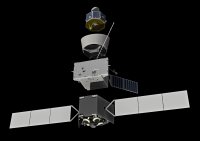BepiColombo To Enter Implementation Phase
26 February 2007
The final approval for the BepiColombo mission to enter the implementation phase has been given last Friday by the Science Programme Committee (SPC) and Astrium GmbH has been selected as Prime Contractor for this scientific Corner Stone mission.The BepiColombo mission entered into its definition phase in July 2001 with a competitive study carried out by two prime contractors, Astrium GmbH and Alcatel Alenia Space–I.
Following a tender procedure in 2006, Astrium GmbH was selected as the prime contractor for the implementation phase (phases B2, C, D and E1) of the mission. An industrial core team, led by the prime contractor, is composed of:
- Astrium GmbH (Friedrichshafen) as Prime Contractor
- Astrium Ltd as Co-Prime Contractor for the Mechanical and Propulsion Bus
- Alcatel Alenia Space Italy as Co-Prime Contractor for the Spacecraft Assembly integration and test, the Communications Subsystem engineering, the MPO thermal control and the Electrical Power Subsystem engineering
- Astrium SAS as subcontractor for the central software
- Tecnologica (E) / IGG (UK) as subcontractor for the Coordinated Parts Procurement
The procurement proposal, based on this industrial core team, has been approved by ESA's Industrial Policy Committee (IPC) at their meeting on 30/31 January 2007.
The degree of technology readiness and the programmatic situation of the science programme enable the BepiColombo project to enter into its implementation phase with a launch planned in August 2013 and a start of the scientific operations around Mercury in 2019.
The BepiColombo Mission
 |
|
The different elements comprising the Mercury Composite Spacecraft |
The MPO will carry eleven highly sophisticated scientific instruments, ten of which will be provided by Principal Investigators through national funding by ESA Member States and one from Russia. The MMO payload consists of five scientific experiments that will also be provided by nationally funded Principal investigators, one European and four from Japan. Significant European contributions are provided to the Japanese instruments.
ESA is responsible for the MPO, including instrument integration, and JAXA is responsible for the MMO. ESA will also be responsible for the integration of both scientific orbiters with the MTM into the MCS, for the launch and for the cruise operations up to the insertion of the MPO and the MMO into their dedicated orbits planned in 2019. Finally, ESA is responsible for the mission and scientific operations of the MPO in its orbit around Mercury.
